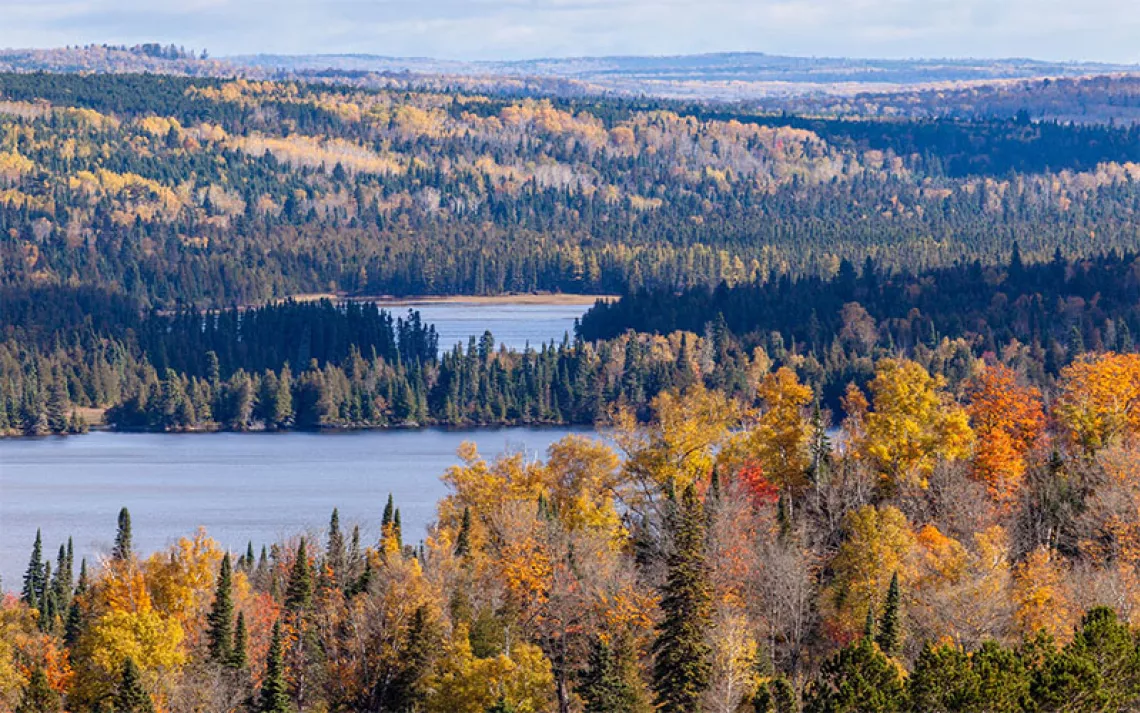Resurrecting Mozambique's Magnificent Gorongosa
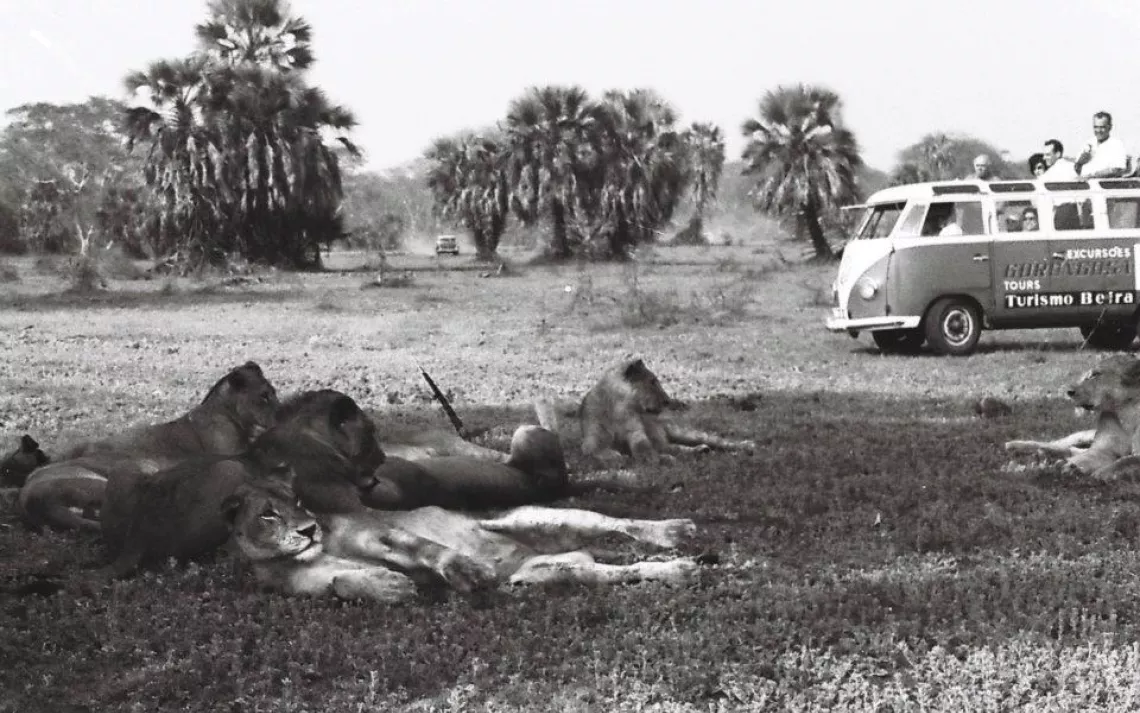
The Serengeti of eastern Africa is one of the boldfaced names of global wilderness, a place that ranks alongside the Amazon, the Sahara, and the Arctic in terms of its hold on the human imagination. Although the Serengeti may be iconic, scientists are still learning new things about how, exactly, that mostly untamed ecosystem works; the Serengeti is a living laboratory. In his new book, The Serengeti Rules: The Quest to Discover How Life Works and Why It Matters (Princeton University Press, 2016), biologist Sean B. Carroll explores all corners of the vast plains in an effort to uncover what lessons the region may have for conservation efforts elsewhere. In this excerpt from the book, Carroll shares the inspiring story of a years-long campaign to reestablish a wildlife preserve in Mozambique after that country’s brutal civil war.
— Jason Mark, Editor in Chief
♦
CHAPTER 10 | RESURRECTION
“All over the rest of Africa the battle is on to save game reserves from the depredations of greed, politics, bad planning, and ignorance. Here in Mozambique it is already won,” proclaimed the November 11, 1970, edition of Durban, South Africa’s The Daily News. The article went on to explain the country’s ambitious aim to expand the “little-known gem” of Gorongosa National Park in central Mozambique into one of Africa’s largest game reserves “where Nature can maintain its balance without outside help.”
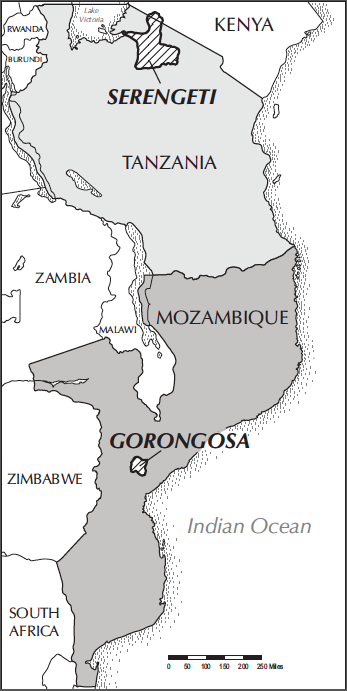
Map of southeastern Africa. | Drawn by Leanne Olds
Behind the grand scheme was young South African ecologist Ken Tinley. The Mozambican authorities hired the doctoral student to study the park’s resources and plan the undertaking. Tinley advocated defining the park’s boundaries in such a way that would reflect and maintain the integrity of its ecosystem. Situated at the southern end of the Great East African Rift, 1,000 miles due south of the Serengeti, the park got its name from the nearby 6,000-foot Mount Gorongosa. The mountain’s rainforest receives about 80 inches of rain per year that feeds the rivers winding through the park. The expanded Gorongosa was to include the mountain as well as the different kinds of habitats in which the animals roamed. Gorongosa had already become a destination for a few of the world’s jet set, who came to marvel at its large lion, elephant, and buffalo populations. Tinley conducted the first aerial survey of the roughly 4,000-square-kilometer park in 1972. He estimated populations of 14,000 buffalo, 5,500 wildebeest, 3,500 waterbuck, 3,000 zebras, 3,000 hippos, and 2,200 elephants. The Gorongosa area lion population numbered about 500. Such figures justified the newspaper’s faith that “foresight and planning will give Mozambique a reserve probably unmatched in Africa.”
After six years of studying the entire Gorongosa ecosystem and making his recommendations for the new contours of the park, Tinley completed his thesis and received his PhD in 1977.
Seventeen years later, Tinley returned as part of a group of scientists who conducted another survey over Gorongosa. Over the course of 40 days, they saw no buffalo, wildebeest, or hippos and estimated that no more than 129 waterbuck, 65 zebras, and 108 elephants remained. The park, whose symbol was a maned lion, had no lions at all. One of the scientists titled his report “A Dream Becomes a Nightmare.”
What the hell happened?
PARADISE LOST
What happened was the hell of the Mozambique civil war. After the Marxist Front for the Liberation of Mozambique drove the Portuguese from Mozambique in 1975, a single-party socialist government was established. In an effort to gain control over every facet of Mozambican society, traditional structures were dismantled. Villagers were forced to relocate into towns or communes. Dissidents were placed in “re-education camps” or convicted in show trials, and many were executed. Within two years, these oppressive measures inspired the formation of the Mozambique Resistance Movement (RENAMO).
The conflict that erupted turned into one of the longest, most brutal, and destructive wars in recent decades. Over the course of 15 years (1977–1992), more than 1 million people were killed in the fighting, thousands were tortured, and 5 million were driven from their homes. RENAMO established its headquarters near Gorongosa, which unfortunately offered the advantages of being situated near the geographic center of the country and of providing refuge and food for the rebels.
As a symbol of the national government, the park was not spared—it was a target. In December 1981, the park’s headquarters was attacked; by 1983, the park was closed to visitors and abandoned. RENAMO deliberately destroyed the park’s school, post office, and health clinic. Gorongosa was the scene of heavy fighting from 1983 to 1992. Both sides shot wild game for food. Even after a peace accord was signed in 1992, the park continued to suffer from rampant poaching, as there were no rangers to stop it.
In 1995, the European Union funded a project to begin to restore some of the park buildings. The small, seasoned team sent to assess the park was shocked when they walked into the former headquarters and found it in ruins, with bullet holes and graffiti all over the damaged buildings and abandoned vehicles. The park itself was a dangerous place, not because of large animals—they were nearly exterminated—but because of landmines.
With no animals and no facilities, there would be no tourists. The future of Gorongosa was grim. And that is how it remained for several years until, more than 7,000 miles away in Cambridge, Massachusetts, an American businessman learned about the park and dared to wonder: Might it be possible to change Gorongosa’s fate, perhaps even to restore it to its former glory?
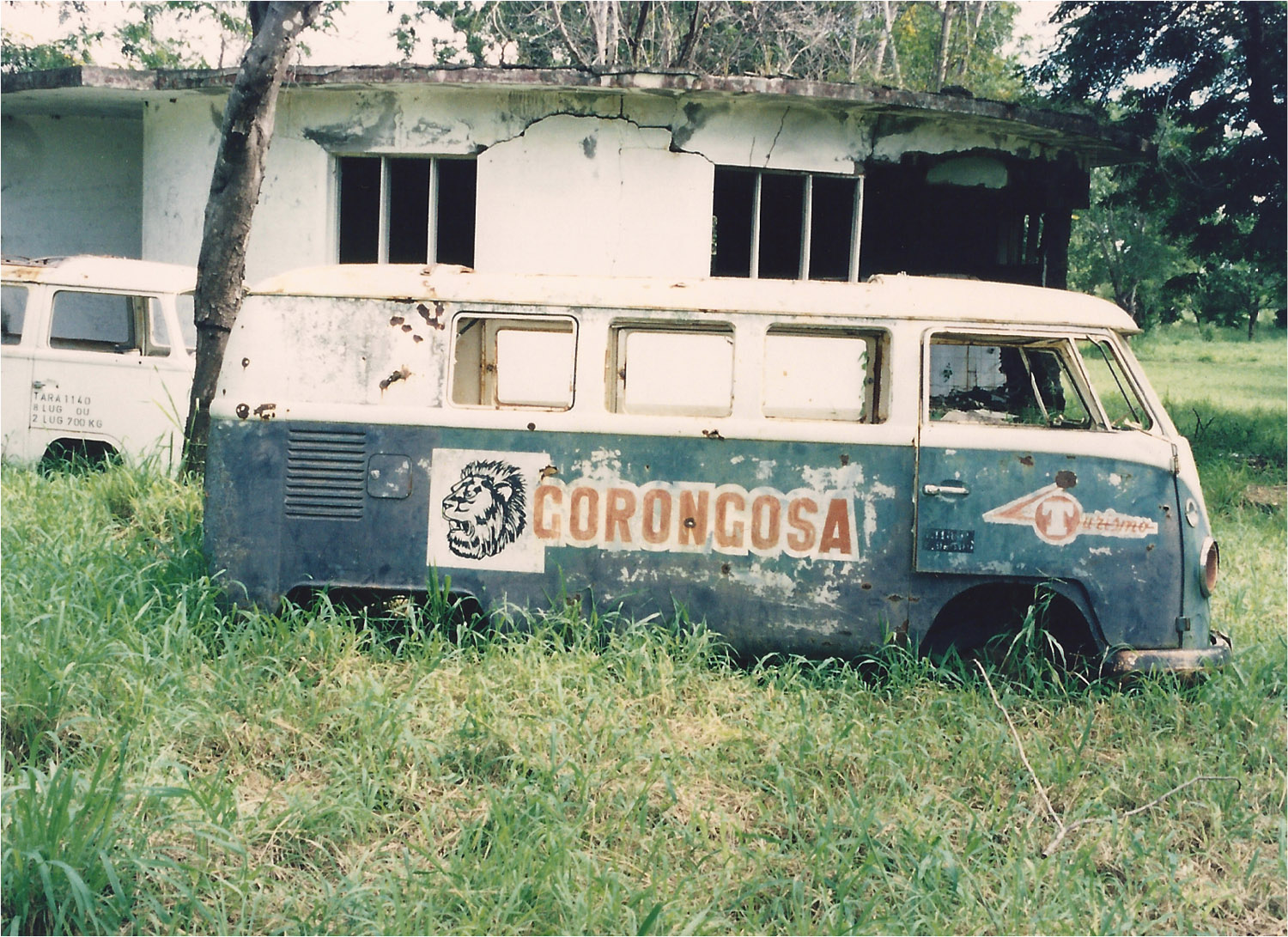
Gorongosa main tourist camp, 1995. | Photo courtesy of Ian Convery
LOOKING FOR A PROJECT
In 2002, 43-year-old entrepreneur Greg Carr was pondering his future. The native Idahoan and Harvard graduate had sold a successful telecommunications business and turned to philanthropy. He started the Carr Foundation in 1999 to focus on human rights, the arts, and the environment. He had endowed a Center for Human Rights Policy at Harvard and launched a new theater company in Cambridge. But Carr was looking for a more “hands-on” project in which to channel his energy, something that might allow him to use his business skills and his wealth to help people.
He began to think a lot about major challenges in Africa, such as the exploding AIDS crisis. Then he had a chat with a Cambridge neighbor, who happened to know Carlos dos Santos, Mozambique’s ambassador to the United Nations. “You should go talk to him,” his friend said.
Since he had never been to Mozambique, Carr read everything he could about the country before going to New York to meet the ambassador. He learned that it was among the poorest countries in the world. Carr told the ambassador that he was looking for a project that promoted economic and human development. “Come to Mozambique,” dos Santos told him, “you can do anything you want.” The ambassador was close to President Joaquim Chissano and offered to introduce Carr.
Carr visited the country for the first time in 2002. He was impressed with the beauty of the country, as well as its great size. Twice the area of California, Mozambique has a 1,000-mile-long coastline. Carr also met with President Chissano, who invited him to “adopt a project.” But the critical turning point for Carr came not in Mozambique, but when he visited neighboring Zambia and went on his first safari.
Seeing both the beauty of wild Africa and the dire poverty of the people, Carr went back home a changed person. He had thought that his money could be used to build much-needed schools, or health clinics, or drinking wells, but it eventually dawned on him that even if young Africans were able to complete their schooling, there were no jobs for them. He reasoned that to make a difference in Mozambique, he needed to create jobs as well as basic infrastructure. And the obvious industry Mozambique could develop was tourism. Every other East and southern African country had a safari industry, but not Mozambique. Why not? Carr learned about the civil war, and why there was no longer any tourism. But he also heard how tourism had once been an economic engine in the 1960s, particularly in a place called Gorongosa.
Carr decided that rebuilding the tourism industry was his best strategy. He also realized that doing so would require healthy national parks, but up to this point in his life, Carr did not know anything about ecology or conservation. So he began devouring the canon of conservation—Henry Thoreau, John Muir, Aldo Leopold, Rachel Carson, and E. O. Wilson.
With a newfound passion for conservation, Carr returned to Mozambique in 2004 with a list of six potential parks to scout. He brought with him Markus Hofmeyr, the top wildlife veterinarian for the famed Kruger National Park in South Africa, as an advisor. They hired a helicopter from the capital Maputo and began their tour at Limpopo, on the border with South Africa and contiguous with Kruger. They then made their way to Gorongosa.
Carr was struck right away with the physical beauty of the place, its massive rainforest-covered mountain, the Great Rift Lake Urema, and its adjoining wetlands. When asked to sign the park’s guest book, he wrote,“This is a spectacular park and it could become one of the best in Africa with some assistance.”
Carr had found his project.
In October 2004, he pledged $500,000 toward the park’s restoration to Mozambique’s Ministry of Tourism. That was to be a small down payment. In November 2005, he agreed to provide $40 million to the park’s restoration over a 30-year period. But this would not be a matter of merely sending checks from the United States. Carr and his foundation were to comanage the endeavor on the ground with the Mozambicans.
The task before him was herculean. When Carr went back to Gorongosa with a team of engineers, tourism developers, economic advisers, and scientists to begin the work, the main camp was still in ruins, there was barely any running water, and they had only a small generator for electricity. Carr spent the nights in the open bed of a pickup truck. The glory of Gorongosa was a forgotten memory. Mozambicans even told Carr, “Don’t bother. There’s nothing there anymore.”
To find out what if anything was still there, Carr commissioned an aerial survey that was taken in the last week of October 2004. The results were mixed. The spotters did count many more waterbuck, reedbuck, and sable antelope than had been seen 10 years earlier at the end of the war. But they saw no zebras, wildebeest, elephants, or buffalo in the survey area—just one lone buffalo outside the grid, and one single lion within it.
When Carr returned home to Cambridge, he was felled by a severe case of malaria—contracted while in his makeshift accommodations. Unable to move, with massive headaches and a recurring high fever, his recovery, let alone Gorongosa’s, was uncertain until he found some Boston doctors who knew how to treat the disease that kills one-half million Africans each year.
Neither his state of health nor the dismal state of Gorongosa deterred Carr. The wildlife survey, however, underscored the big question of where and how to start in restoring the park. This was not a case of one or two predators that had been selectively removed. Few places in the world were as broken as Gorongosa: Entire chains in the food web had been and remained decimated.
REBUILDING FROM THE BOTTOM UP
While Gorongosa had been famous for its lions—and that’s what tourists want to see—the top of the food chain was obviously not the place to start rebuilding, since their prey had been wiped out. Rather, it was clear that the large grazers should be the priority. Their absence had led to major changes in the park’s vegetation. Without elephants browsing, woodlands had expanded, and without the large grazers, the grasslands grew tall and fed frequent, intense dry-season fires.
Gorongosa needed animals, but where could Carr find them? The first offer came in from Kruger National Park: 200 disease-free African buffalo. Populations in southeastern Africa were commonly infected with tuberculosis and brucellosis, but Kruger had segregated a population and kept them healthy.
With animals so precious and poaching an ever-present threat, one of the first concerns was where to put the buffalo so that they would be safe and able to thrive. When Carr and Hofmeyr had visited Limpopo, they saw a sanctuary that had been erected in the park. Hofmeyr recommended that Carr do the same for Gorongosa and picked out a 15,000-acre area for a fully fenced, well-patrolled “Sanctuario” that would keep the new arrivals free from any lions or poachers and give them the best head start in rebuilding the Gorongosa population.
The first batch of 54 animals arrived in August 2006. “It was an incredible gift,” Carr recalled. But still, the pre-war buffalo population was 14,000. Carr worried that he would need to truck in animals every week for 10 years to rebuild the grazer populations. Not only would that be expensive, but the 600-mile journey from South Africa to the park was traumatic for the animals.
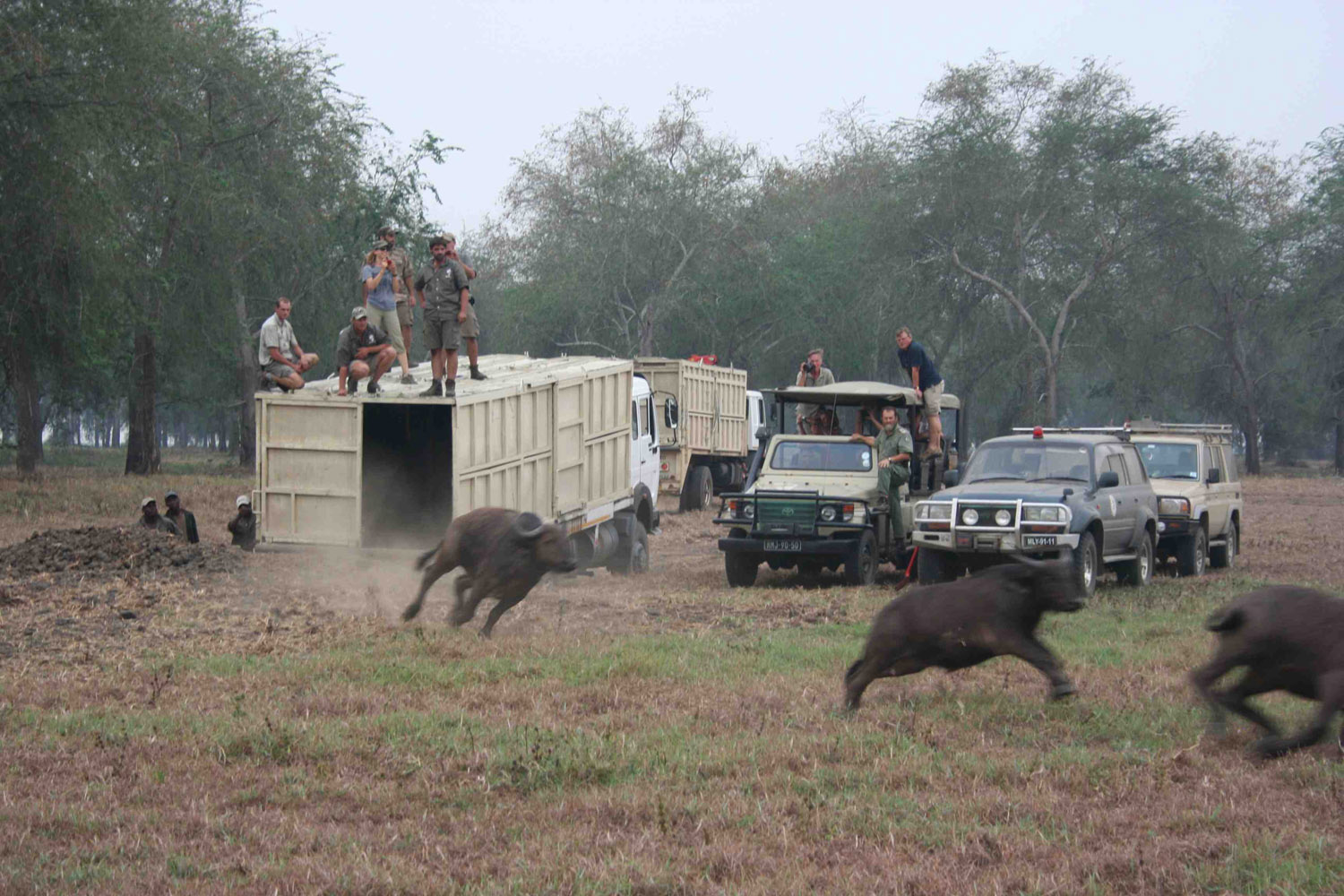
First buffalo released in Gorongosa National Park in August 2006. | Photo by Domingos Muala, courtesy of the Gorongosa Restoration Project
Carr soon found out that getting animals, especially the right ones, was going to be much more difficult than that first batch of buffalo. Gorongosa had been home to a distinct subspecies of zebra called Crawshay’s zebra, one that has thinner black stripes that extend all the way across their underbellies. The subspecies was once widely distributed across southeastern Africa but had become restricted to a few conservation areas. Carr’s scientific team did not want to extinguish the subspecies by bringing in the more common zebra, so they waited several years and worked patiently to get a grand total of 14 Crayshay’s zebras from other provinces in Mozambique, which they also introduced into the Sanctuario. One-hundred-eighty wildebeest were similarly introduced into the Sanctuario in 2007, while six elephants and five hippos obtained from other parks were released directly into the park in 2008, as well as 35 eland in 2013.
Now more than 10 years since the restoration project began, how are the animals faring? I went to Gorongosa to see for myself.
A GIANT SALAD BOWL
Pilot Mike Pingo picked us up in his bright-red five-seat helicopter at Beira’s airport, near the coast and about 80 miles southeast of the park (the “us” in this story being myself, my wife Jamie, and Dennis Liu and Mark Nielsen, two colleagues from the Howard Hughes Medical Institute’s Department of Science Education). With relatively few roads, and most of those unpaved in this marshy part of the country, the chopper provided a much faster final leg to our 26-hour journey, as well as a bird’s-eye view of the scenery below.
We passed over miles of flat, largely empty terrain; occasional clumps of trees; and a few small villages, consisting of a handful of thatched huts and small plots of maize and other crops. Then, we started to climb a bit and crossed into the park. My first impression was that Gorongosa was much more heavily forested than I expected, with many tall and short palm trees, and beautiful stands of “fever” trees with green-tinged bark, not at all like the acacia-dominated Serengeti. As we came upon Rio Urema, one of several rivers winding through the park, Pingo started banking left and right over its snaking contours. A few large birds took flight below us, and then I saw them.
Crocodiles! Yellow- and black-checkered Nile crocodiles were lining almost every muddy bank or spit. I had seen a good number of crocs before in northern Australia, but never this many nor so close together, 20 or more on a single 100-foot-long mudbank, including some 15-footers. Here was at least one species that was doing well in Gorongosa. The slumbering giants quickly rose as we approached and slid gently into the river. A marvelous sight for this reptile lover.
We then landed at the small airstrip outside the main camp called Chitengo, where Greg Carr and many of his colleagues involved in the Gorongosa Restoration Project (GRP) met us, along with a few warthogs and baboons.
“Would you like to go on a game drive, or would you rather rest after your long trip?” Greg asked (I am breaking form here and will use his first name). It was three in the afternoon; the sun would set in a couple of hours. Adrenaline trumped fatigue, and we were soon in an open-air safari truck bouncing down one of the park’s dirt roads. We quickly spotted some impala bounding through the thickets and a few shy oribi (a small antelope). Near several small water holes, we saw many waterbuck—a large antelope with a distinct white circle on its rear end. We stopped to admire several birds, including an eagle and a kingfisher.
The trees and tall grass eventually ended at an enormous floodplain. We pulled off the road and climbed out of the truck to take in a breathtaking panorama. The foreground was carpeted with lush green grass and forbs, and was cut by a wide stream and its side-channels, which attracted flocks of yellow-billed storks, whistling ducks, and spur-winged geese. The plants were being grazed by scores of waterbuck and impala. In the background, on the horizon, at the western edge of the Great African Rift, stood massive Mount Gorongosa, whose rainfall swells the waters of Lake Urema, a vast, shallow lake on the floor of the Rift Valley to our north.
“Not a human being, not a light, not a road,” Greg noted, as the sun painted a pink-orange backdrop to the Rift. If wowing us upon arrival was his aim—mission accomplished.
In the ensuing days, I would appreciate much more about the critical connections between the mountain, the rivers and lake, the floodplain, and the wildlife populations, aided in large part by a helicopter flight over Lake Urema and the floodplain. From the air, I could see that the greatest concentrations of mammals anywhere in the park were on the green floodplain, including large pods of hippos and herds of antelope. The simple question then was How and why is this so? What made that floodplain?
While the size of the lake was impressive, and the floodplain stretched for miles in all directions away from it, this was Gorongosa’s dry season (June). I learned that months earlier, most of the plain was underwater, and the lake swollen to many times its present size. The water’s retreat during the dry season exposes a huge amount of land that, freshly fertilized with silt and well watered, becomes a giant salad bowl in the valley. That salad feeds a lot of wildlife until the rains return in November.
But of all the mammals in Gorongosa, Greg knew that one species was most important to the recovery of the park and its ecosystems—Homo sapiens. The human population surrounding the park is about 250,000, and most subsist on less than one dollar per day. To be successful in the long run, Gorongosa would have to prove to be more valuable as an intact preserve than as farmland, timberland, and larder. Greg was just as eager to show me the many ways in which the GRP was helping the surrounding communities as he was for me to see the wildlife.
HUMAN DEVELOPMENT
In creating jobs for and providing services to the surrounding community, the GRP has, in fact, spent as much money outside the park as inside it. The restoration project provides direct employment to hundreds of area residents. One of the most important jobs for the recovery of wildlife populations is the patrolling of the park to suppress poaching, overfishing, clear-cutting of trees, crop planting, and the illegal setting of fires. One-hundred-twenty armed park rangers, most recruited from the local area, walk for days at a time across the vast wilderness to find and destroy thin wire snares, the most common form of trap that can maim or kill many species. They are also responsible for locating and arresting the poachers who set them. It is difficult, dangerous work. The rangers also have to manage animal-human conflicts, even if that means guarding a villager’s crops at night from raiding elephants.
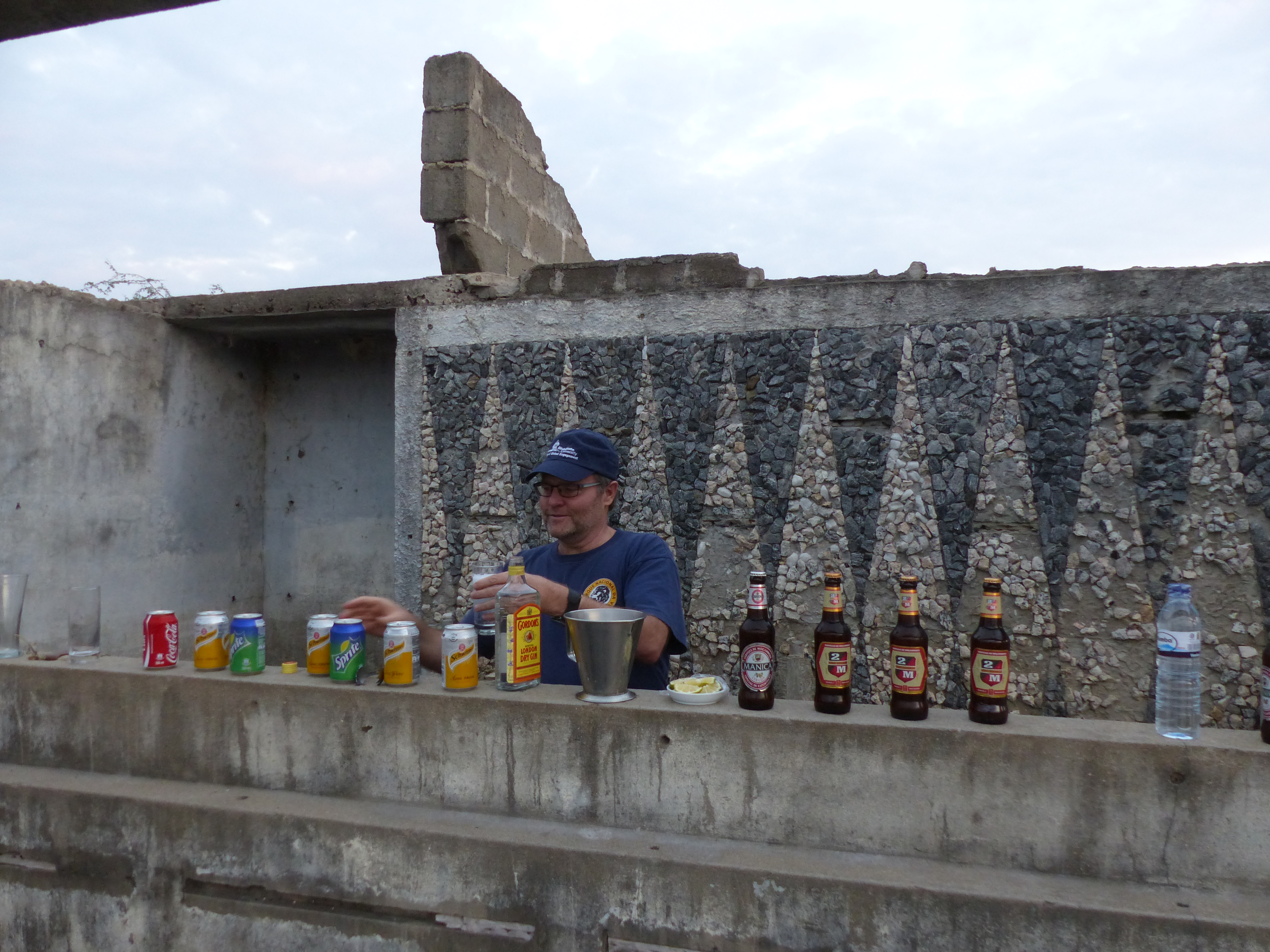
Greg Carr, philanthropist and bartender, serving refreshments from a makeshift bar at Gorongosa’s “Hippo House,” an abandoned concrete shell overlooking a hippo pool. | Photo by Sean B. Carroll
Tourism is another source of jobs and community revenue. To begin to rebuild the tourist industry, 60 local scouts were hired in 2006 to guide tourists up Mount Gorongosa. In 2007, new tourist bungalows were opened in the main camp area. A beautiful open-air restaurant was added, as well as a swimming pool. While fewer than 1,000 tourists visited in 2005, 8,000 came in 2008. The policy was established in 2009 that 20 percent of tourism revenues would go to surrounding communities, which are then allocated by local committees to various projects, such as schools, health posts, and fire control. While Mozambique is poor, the Gorongosa district is among the poorest in the country, and most residents lack access to basic education and healthcare. In 2006, the GRP built a health clinic in Vinho, a community immediately adjacent to the park’s southern border, on the other side of the Rio Púnguè. In 2009, a mobile health clinic was launched that provides vaccinations, prenatal and family planning services, and disease prevention tools to surrounding communities. To help curb malaria, mosquito nets were distributed to all 250,000 people in the buffer zone around the park.
The GRP also built a primary school in Vinho in 2006, which previously had none. And in 2010, a Community Education Center was built close to the town of Vila Gorongosa that provides programs for thousands of area children to learn about the local flora and fauna and basic environmental principles, and for area farmers to learn about sustainable agricultural methods. The GRP is providing agricultural expertise to help villagers implement more productive and efficient farming methods and to plant new crops. The simple conservation premise is that if land is used more efficiently outside the park, and food security is improved, there will be less pressure on park lands. On the day we visited the Community Education Center, two dozen farmers were learning about developing coffee crops on the slopes of Mount Gorongosa.
That undertaking may in fact be the most critical to protecting the park’s most vital resource—the water that flows from the mountain. Lake Urema and most of the park rivers do not dry up during the long and increasingly hot dry season. They continue to provide habitat and drinking water, because water continues to flow year-round from Mount Gorongosa. Its rainforest acts like a sponge, soaking up rainfall during the wet season and then steadily releasing it during the long dry season. That flow helps maintain the overall water table in the salad bowl. Water from the mountain, then, is the lifeblood of the Gorongosa ecosystem.
But the mountain’s hardwood rainforest has been rapidly reduced by clear-cutting and the planting of food crops, such as maize. Without the trees, the mountain retains less water and the soil washes away. The maize crops do not fare well for long, and then more forest gets cut down. The GRP had to develop some plan to halt and perhaps reverse the destruction of the mountain rainforest. To motivate farmers to behave differently, the GRP had to identify an alternative crop that was more valuable than maize and was compatible with the regrowth of the forest.
The solution? Shade-grown coffee.
The GRP has established an impressive nursery high up the slope of Mount Gorongosa, where we saw over 40,000 potted plants ready to go into the ground. To help the coffee get established, the seedlings are planted alongside pigeon pea, a rapidly growing staple crop that will shade the young plants and provide food and income to the farmers in the meantime. In addition to 2,200 coffee plants, 90 hardwood rainforest trees are being planted on each hectare that will eventually shade each orchard. In the long run, the GRP hopes to reforest a large section of the mountain while establishing a thriving coffee business: the imperatives of conservation met with the imperative of economic and human development.
But the GRP’s ambitions have met setbacks. RENAMO has continued as a political and paramilitary organization, and its conflict with the government flared up again in 2013–2014, causing the temporary closure of the park and forcing GRP personnel off the mountain. The parties have signed a new peace agreement, but their political disputes continue.
And then there is the matter of poaching. The top predator of mammals in Gorongosa is not the crocodile or lion; it is humans. In a span of just nine days, I happened to see three pickup trucks carting four or five poachers each to the park’s detention center. While poaching in Gorongosa is largely a matter of trapping for meat—and not the slaughter of elephants for their ivory, as in much of East Africa—Pedro Muagura, the director of conservation, told me that regardless of how many arrests they make, poaching is a relentless, daily toll on park wildlife. Given this reality, I was eager to know what was happening to the numbers of animals, which was impossible to gauge merely from our game drives.
A SALAD, NOW WITH MORE MEAT
On a Saturday night, we were invited to join several scientists and much of the park management as they gathered in an open-air conference room near the airstrip to discuss the state of park wildlife. Early in the genesis of the GRP, Greg was keen to invite the world’s scientific community to come study Gorongosa’s animals and plants. Biologists from several universities studying kudu, bushbuck, lions, and even termites were present.
The presentation was kicked off by Marc Stalmans, African wildlife expert and Gorongosa’s director of scientific services, who had led the most recent aerial survey over the park at the end of the last dry season. Over a span of 12 days, Stalmans and a crew of five flew 29 sorties back and forth across the Rift Valley in Mike Pingo’s helicopter (with the doors off), counting all mammals that were large enough to spot from the air—19 species of herbivores in all.
The grand total of animals spotted: 71,086!
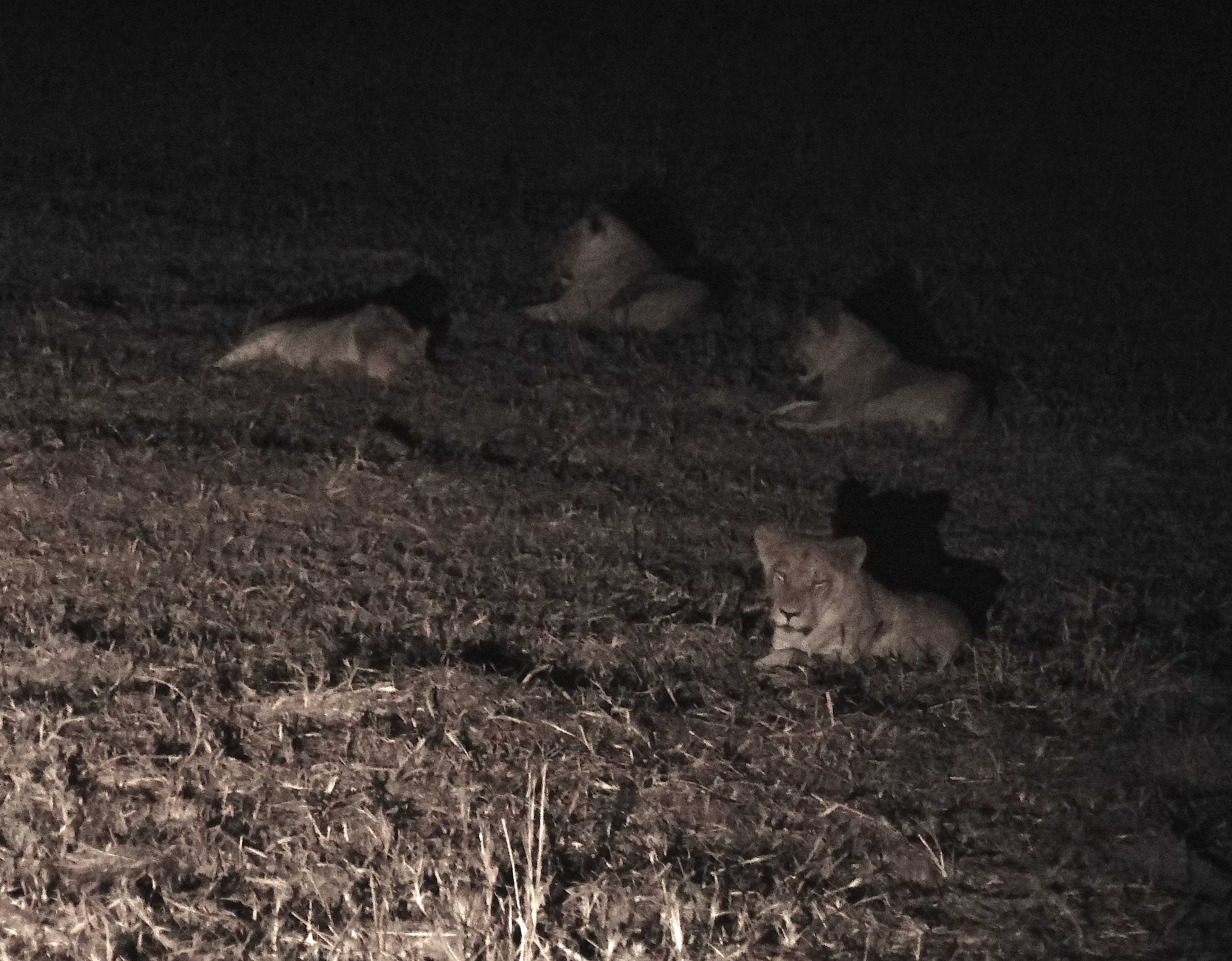
Lions in Gorongosa. | Photo by Sean B. Carroll
The number is particularly astonishing considering that in 2000, there were fewer than 1,000 elephants, hippos, wildebeest, waterbuck, zebras, eland, buffalo, sable, and hartebeest combined. Today there are almost 40,000 individuals of these species, including 535 elephants and 436 hippos. Stalmans reported that almost every species they surveyed had increased considerably from recent counts, and most dramatically so from the surveys taken before the start of the restoration project. In just seven years, the density of waterbuck and impala has quadrupled and doubled, respectively, and the number of sable antelope and waterbuck now exceed their historical numbers from the 1960s and 1970s. And all of this has happened despite losses from poaching.
For Greg Carr, the transformation is thrilling. Just 10 years ago, visitors could drive all day and see only an occasional animal where now there are herds. He is particularly excited (and relieved) by the fact that he did not have to truck in most of those 70,000 additional animals: nature did most of the work.
“You give nature half a chance, and it’s resilient.” Greg said. That chance was provided by Gorongosa’s park rangers, who have protected the rebounding populations.
That resilience is Serengeti Rule 5 in action. The rapidly rebounding populations are exhibiting exactly the same phenomenon that buffaloes, elephants, and wildebeest did in the Serengeti. When populations are at low densities, much lower than their habitat can support, their rates of increase can be very high. Gorongosa’s researchers calculate that several species have been increasing at more than 20 percent per year. That is on par with the rapid explosion of wildebeest and buffalo in the Serengeti after the extermination of rinderpest.
Indeed, given adequate protection and habitat, many species across the world have rebounded dramatically from severely reduced numbers. For example, the northern elephant seal was reduced to as few as 20 individuals in the late 1800s and numbers more than 200,000 today, Western Australian humpback whales have rebounded from 300 to 26,000 in 50 years, North Pacific sea otters from 1,000 to 100,000 over the past century, and the American alligator has recovered from near extinction to a population of about 5 million in 50 years.
While the reintroduction of some species may sometimes be necessary, Greg has drawn one lesson from Gorongosa’s experience that may guide other large-scale restoration efforts: “Focus on law enforcement, not reintroduction.”
But the transformation of Gorongosa is far from complete. Still more grazers are needed, especially buffalo, to cut down on the overgrowth of grasses. And herbivores are not the only important mammals. What about the carnivores? There are no hyenas or leopards in the park; lions are the only large carnivore in Gorongosa. While they have rebounded somewhat from near extermination, they are still at historically low numbers, with just 63 individuals tallied at last count. Their scarcity means there is little top-down regulation of prey, which might be contributing to the rapid increase of some of the herbivores. Their rarity would also explain why we had seen every one of the 19 large herbivore species in the course of several game drives, but not any cats.
One big question the scientists would love to know the answer to: For how long might animal numbers increase in Gorongosa before leveling off? In the Serengeti, that was when the growth curves turned downward. One fundamental limit to population growth is the total amount of animal biomass that can be sustained by the food and water present in a given area, known as the carrying capacity of an ecosystem. Stalmans has estimated that Gorongosa could support about 8,000 kilograms of animals per square kilometer, with greater densities within the floodplain. The 2014 survey revealed an overall density of about 5,500 kilograms of herbivores per square kilometer, so there appears to be plenty of room for further increases. There is no sign yet that any populations are reaching levels where competition or density-dependent regulation are slowing their increase.
The focus on the numbers of large, visible, and tourist-attracting mammals, while understandable and generally good news, does however tend to overshadow other indicators of Gorongosa’s health and importance. That indicator would be the overall biological diversity in the park, and this is where Gorongosa really stands out. Despite all the trauma it has experienced, it is because of the variety of habitats within Gorongosa—rainforest, sand forest, riverine forest, miombo woodlands, limestone caves, grasslands, and floodplain—that it may currently provide home to more species than any other park in Africa. Biologists have estimated there are at least 35,000 species of plants and animals in Gorongosa, including, for example, more than 30 kinds of bats and about 400 bird species. Thanks to our extraordinary guide Fraser Gear, we were able to see a wide variety of residents, including several nocturnal creatures, such as genets; bush babies; various types of mongoose; and my favorite, civets, a beautiful striped and spotted, catlike mammal.
During our last evening in Gorongosa, Fraser took us back to that panorama over the floodplain for one last sunset, then back to camp in the dark. I hoped to see another civet, and Fraser came through as usual. I was then content to just gaze up at Jupiter and Venus in the southern sky, but Fraser stopped, examined some tracks in the road, and pulled off into bush. Sweeping his spotlight back and forth, he rolled us slowly through the tall grass. I had seen the same skill the night before when he tracked a call to a very rare Pel’s fishing owl perched over a waterhole. He again made his way to the edge of a waterhole, but when he cast the spotlight to the other side, we saw that he was not tracking an owl. Two lions stared right back at us. A third walked straight at our open-air truck before lying down just 20 feet in front of us. A wider sweep revealed a fourth, a fifth, and still more lions lounging around the bank of the pond, nine in all, including several youngsters. The pride was growing.
Heart pounding, I didn’t dare even whisper, but two words came to mind: Viva Gorongosa. ♦
 The Magazine of The Sierra Club
The Magazine of The Sierra Club



